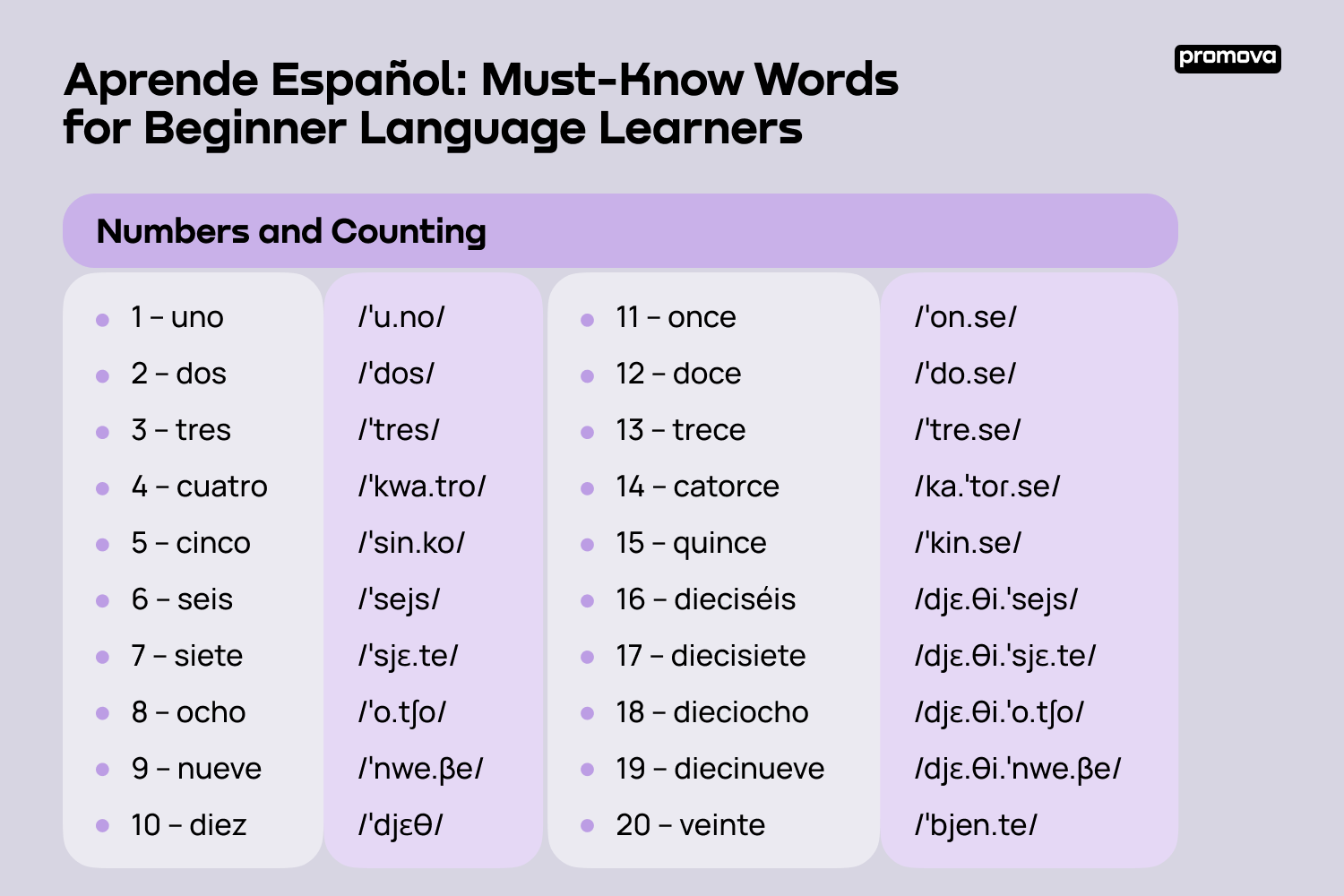Aprende Español: Must-Know Words for Beginner Language Learners


You will get a promo code with a discount for our app courses after reading this article.
Contents
Did you know that almost 8% of the world’s population speaks Spanish? Moreover, it ranks 4th among the most spoken languages worldwide, losing only to English, Hindi, and Mandarin Chinese. That is why we are not surprised about the number of people seeking to learn some useful Spanish words.
Today’s article will help you build a strong foundation in vocabulary to develop your language skills. You’ll gain confidence in understanding and expressing yourself in everyday conversations by mastering essential terms and phrases right from the start. So, what are you waiting for? Let’s go! Or, wait. It would be better to say, ¡Vamos!
Getting Started: Spanish Basic Vocabulary
Understanding basic vocabulary is key to starting your journey, whether you’re planning to learn Spanish for work, travel, or simply want to acquire a new language as a hobby. Don’t try to memorize difficult sentences or phrases immediately. Begin with something simple, like Spanish words basic. This way, you won’t feel exhausted by a ton of new information and will see progress much faster and easier. And we always want to help you, so check our comprehensive guide to easy Spanish words to get you started.
Greetings and Introductions
Communication with locals is inevitable if you plan to travel to Spain for fun, work, or other purposes. Whether it be small talk with strangers, a business meeting, or a full-fledged conversation, you would say a greeting first. In Spanish, you can use the words:
- Hola – /ˈola/ – Hi/hello.
- Buenos días – /ˈbwe.nos ˈði.as/ – Good morning.
- Buenas tardes – /ˈbwe.nas ˈtar.des/ – Good afternoon.
- Buenas noches – /ˈbwe.nas ˈno.tʃes/ – Good night.
These are the most common greetings that can be used in both formal and informal settings. However, just like in English, some phrases can also count as a greeting, even if there is no “hello” in them. For example:
- ¿Qué tal? – /ke ˈtal/ – What’s up?
- ¿Cómo te va? – /ˈko.mo te ˈβa/ – How’s it going?
- ¿Qué haces? – /ke ˈa.ses/ – What are you doing?
- ¿Qué pasa? – /ke ˈpa.sa/ – What’s happening?
After greeting your interlocutors with these easy Spanish words, it is time to introduce yourself. Here are some of the most common phrases to say your name or ask the name of the person you are talking to:
- Me llamo /nombre/ – /me ˈʝa.mo [nombre]/ – My name is /name/.
- Mi nombre es – /mi ˈnom.bre es/ – My name is /name/.
- Hola, soy /nombre/ – /ˈo.la, soi [nombre]/ – Hi, I’m /name/.
- ¿Cómo te llamas? – /ˈko.mo te ˈʝa.mas/ – What is your name?
And now that you know these common Spanish words for greetings, you can memorize some phrases to keep the conversation going. For example, you can tell a bit more about yourself using these widespread expressions:
- Yo tengo … años – /jo ˈten.ɡo ... ˈa.ɲos/ – I am … years old.
- Yo soy de – /jo soi de/ – I am from ….
There you go! By learning these Spanish words for beginners, you can already greet someone and even introduce yourself. But, of course, we won’t stop here. Let’s move to the next topic and enhance your Spanish vocabulary even more.
Numbers and Counting
Regardless of the language you are learning, this topic will be among the first. Understanding the numbers is essential, as we use them in many situations – when purchasing things, talking about our age, time, and other important stuff. So, how can you count to twenty in Spanish?
- 1 – uno – /ˈu.no/.
- 2 – dos – /ˈdos/.
- 3 – tres – /ˈtres/.
- 4 – cuatro – /ˈkwa.tro/.
- 5 – cinco – /ˈsin.ko/.
- 6 – seis – /ˈsejs/.
- 7 – siete – /ˈsjɛ.te/.
- 8 – ocho – /ˈo.tʃo/.
- 9 – nueve – /ˈnwe.βe/.
- 10 – diez – /ˈdjɛθ/.
- 11 – once – /ˈon.se/.
- 12 – doce – /ˈdo.se/.
- 13 – trece – /ˈtre.se/.
- 14 – catorce – /ka.ˈtoɾ.se/.
- 15 – quince – /ˈkin.se/.
- 16 – dieciséis – /djɛ.θi.ˈsejs/.
- 17 – diecisiete – /djɛ.θi.ˈsjɛ.te/.
- 18 – dieciocho – /djɛ.θi.ˈo.tʃo/.
- 19 – diecinueve – /djɛ.θi.ˈnwe.βe/.
- 20 – veinte – /ˈbjen.te/.
To count beyond 20, you can use a combination of the numbers. For example, 21 would be “veintiuno,” literally meaning “twenty-one.” Similarly, you can continue this pattern for higher numbers. To form words in the hundreds, just memorize the word “cien,” which means one hundred, and combine it with the corresponding digit. For example, two hundred will be doscientos/as, three hundred – trescientos/as, etc.

Colors and Descriptions
The third topic of Spanish words for beginners contains numerous adjectives. They are also essential for your learning, as they help you easily describe the things you are talking about. For starters, let’s memorize some basic colors in Spanish:
- Rojo/roja – /ˈro.xo/ /ˈro.xa/ – red.
- Azul – /a.ˈθul/ – blue.
- Amarillo/amarilla – /a.ma.ˈɾi.ʝo/ /a.ma.ˈɾi.ʝa/ – yellow.
- Verde – /ˈβeɾ.ðe/ – green.
- Naranja – /na.ˈɾaŋ.xa/ – orange.
- Morado/morada – /mo.ˈɾa.ðo/ /mo.ˈɾa.ða/ – purple.
- Rosa – /ˈro.sa/ – pink.
- Negro/negra – /ˈne.ɣɾo/ /ˈne.ɣɾa/ – black.
- Blanco/blanca – /ˈblaŋ.ko/ /ˈblaŋ.ka/ – white.
- Gris – /ˈɡɾis/ – grey.
But, of course, colors are not the only option when describing something. Many other adjectives express emotions, states, appearances, and much more. So why don’t we provide some more examples of Spanish words to learn? Check them out below!
- Grande – /ˈɡɾan.de/ – big.
- Pequeño/pequeña – /pe.ˈke.ɲo/ /pe.ˈke.ɲa/ – small.
- Feliz – /fe.ˈlis/ – happy.
- Triste – /ˈtɾis.te/ – sad.
- Hermoso/hermosa – /eɾ.ˈmo.so/ /eɾ.ˈmo.sa/ – beautiful.
- Feo/fea – /ˈfe.o/ /ˈfe.a/ – ugly.
- Caliente – /ka.ˈljen.te/ – hot.
- Frío/fría – /ˈfɾi.o/ /ˈfɾi.a/ – cold.
- Cansado/cansada – /kan.ˈsa.ðo/ /kan.ˈsa.ða/ – tired.
- Ocupado/ocupada – /o.ku.ˈpa.ðo/ /o.ku.ˈpa.ða/ – busy.
These simple terms will help you describe objects, people, and the world around you in Spanish. But remember that the best way to memorize them is by practicing them in daily conversations. And here is one quick tip for you – adjectives in Spanish agree in number and gender with the noun they modify. For example, bicicleta roja (red bicycle, which in Spanish is a feminine noun) – coche rojo (red car, masculine noun). Keep that in mind next time you use them in sentences!
Navigating Daily Life: Essential Words in Spanish
And now that we’re done with the basics, it is time to move to our next topic. Here, we will discuss common places and things that surround us daily. Check these easy Spanish words to learn and take your basic conversations to a new level.
Common Objects and Places
Let’s start simple. Take a look around yourself – what do you see? There are probably many things, depending on where you are right now. So, let’s play a game where we’ll try to name at least a few things you can see right now. Except we’ll do it using basic words in Spanish!
- Mesa – /ˈme.sa/ – table.
- Silla – /ˈsi.ʎa/ – chair.
- Libro – /ˈli.bɾo/ – book.
- Bolígrafo – /bo.ˈli.ɣɾa.fo/ – pen.
- Teléfono – /te.ˈle.fo.no/ – phone.
- Coche/auto – /ˈko.tʃe/ /ˈau̯.to/ – car.
- Llave – /ˈʎa.βe/ – key.
- Bolsa – /ˈbol.sa/ – bag.
- Zapato – /θa.ˈpa.to/ – shoe.
- Sombrero – /som.ˈbɾe.ɾo/ – hat
Did we forget anything? Please tell us in the comments! And to continue our fun with casual Spanish terms, let’s play another round. Now, we’ll name the place you are at this moment.
- Casa – /ˈka.sa/ – house.
- Escuela – /es.ˈkwe.la/ – school.
- Parque – /ˈpaɾ.ke/ – park.
- Restaurante – /res.tau̯.ˈɾan.te/ – restaurant.
- Hospital – /os.pi.ˈtal/ – hospital.
- Playa – /ˈpla.ʝa/ – beach.
- Tienda – /ˈtjen.da/ – store.
- Banco – /ˈbaŋ.ko/ – bank
- Aeropuerto – /ae̯.ɾo.puer.to/ – airport.
- Ciudad – /θju.ˈðað/ – city.
These common words in Spanish, combined with the previously mentioned colors and adjectives, can help you easily explain your thoughts to native speakers and achieve a better communication experience.
Food and Drinks
Learning new words requires a lot of effort and energy. The best (and yummiest) way to replenish it is to have some food. So why don’t you get yourself a snack? And meanwhile, we will tell you about some popular food names in Spanish.
- Pan – /pan/ – bread.
- Arroz – /a.ˈros/ – rice.
- Pasta – /ˈpas.ta/ – pasta.
- Carne – /ˈkar.ne/ – meat.
- Pollo – /ˈpo.ʎo/ – chicken.
- Pescado – /pe̞s.ˈka.ðo/ – fish.
- Ensalada – /en.sa.ˈla.ða/ – salad.
- Fruta – /ˈfɾu.ta/ – fruit.
- Verduras – /be̞ɾ.ˈðu.ɾas/ – vegetable.
- Manzana – /man.ˈsa.na/ – apple.
- Plátano – /ˈpla.ta.no/ – banana.
- Fresa – /ˈfɾe.sa/ – strawberry.
- Queso – /ˈke.so/ – cheese.
In addition to that, there are many drinks and beverages you might want to have after a good meal. So why don’t you choose something from the list below?
- Agua – /ˈa.ɣwa/ – water.
- Café – /ka.ˈfe/ – coffee.
- Té – /te̞/ – tea.
- Leche – /ˈle̞.tʃe̞/ – milk.
- Jugo – /ˈxu.ɣo/ – juice.
- Refresco – /ɾe̞.ˈfɾes.ko/ – soda.
- Cerveza – /θe̞ɾ.ˈβe̞.θa/ – beer.
- Vino – /ˈbi.no/ – vine.
- Cóctel – /ˈko.ktel/ – cocktail.
- Limonada – /li.mo.ˈna.ða/ – lemonade.
These are just a few examples of common food and drink items. But you can feel free to explore more and enrich your vocabulary as you delve into the exciting world of Spanish cuisine. So, enjoy your meal! ¡Buen provecho!
Time and Dates
Understanding how to express time is essential for effective communication in any language. In Spanish, time-related vocabulary lets you talk about daily routines, appointments, scheduled events, etc. For starters, let’s learn how to call different parts of the day in Spanish.
- Mañana – /ma.ˈɲa.ɲa/ – morning.
- Tarde – /ˈtar.de/ – afternoon.
- Noche – /ˈno.tʃe/ – night.
- Medianoche – /me.ˈðja.no.tʃe/ – midnight.
- Mediodía – /me.ˈðjo.ði.a/ – midday.
- Hora – /ˈo.ɾa/ – hour.
- Minuto – /mi.ˈnu.to/ – minute.
- Segundo – /se.ˈɣun.do/ – second.
- De la mañana – /de la ma.ˈɲa.ɲa/ – AM.
- De la tarde/noche – /de la tar.de/no.tʃe/ – PM.
And now, it is time to expand your vocabulary even more by talking about the days of the week. We are all used to English weekdays, but it is hard not to notice how beautiful their names sound in Spanish.
- Lunes – /ˈlu.nes/ – Monday.
- Martes – /ˈmar.tes/ – Tuesday.
- Miércoles – /ˈmjɛɾ.ko.les/ – Wednesday.
- Jueves – /ˈxwe.βes/ – Thursday.
- Viernes – /ˈbjeɾ.nes/ – Friday.
- Sábado – /ˈsa.ba.do/ – Saturday.
- Domingo – /do.ˈmiŋ.go/ – Sunday.
Congratulations! Now you know Spanish names for parts of the day and days of the week. But why stop there? Let’s dive even deeper and explore the names of the months in Spanish!
- Enero – /e.ˈne.ɾo/ – January.
- Febrero – /fe.ˈbɾe.ɾo/ – February.
- Marzo – /ˈmar.θo/ – March.
- Abril – /a.ˈβɾil/ – April.
- Mayo – /ˈma.ʝo/ – May.
- Junio – /ˈxu.njo/ – June.
- Julio – /ˈxu.ljo/ – July.
- Agosto – /a.ˈɣos.to/ – August.
- Septiembre – /sep.ˈtjem.bɾe/ – September.
- Octubre – /ok.ˈtu.bɾe/ – October.
- Noviembre – /no.ˈβjem.bɾe/ – November.
- Diciembre – /di.ˈθjem.bɾe/ – December.
Days turn into months, and months – into years. And every year has four seasons. By the way, what is your favorite one? Because we like all of them equally. Nevertheless, when you share your favorite season in the comments, write its Spanish name!
- Primavera – /pɾi.ma.ˈβe.ɾa/ – spring.
- Verano – /be.ˈɾa.no/ – summer.
- Otoño – /o.ˈto.ɲo/ – autumn.
- Invierno – /in.ˈbjeɾ.no/ – winter.
Phew, there was indeed a lot of information. And although we’ve provided you with a lot of new Spanish words, don’t try to learn them all at once! Just focus on one topic at a time, and do your best to memorize not only the pronunciation but also the usage of these words in different sentences. Go easy on yourself, and remember that even the smallest steps can lead to the biggest results.
12
Practical Communication: Useful Spanish Terms and Phrases
By knowing the basic Spanish words from above, you will be able to convey simple ideas to locals. However, it might not be enough for a meaningful dialogue. But don’t worry! Here are some practical phrases that can come in handy during a conversation with native speakers.
- Perdón – /peɾ.ˈðon/ – Excuse me.
- Por favor – /poɾ fa.ˈβoɾ/ – Please.
- Gracias – /ˈɡɾa.θjas/ – Thank you.
- De nada – /de ˈna.ða/ – You are welcome.
- Lo siento – /lo ˈsjen.to/ – I’m sorry.
- ¿Me puedes ayudar? – /me ˈpwe.ðes a.ʝu.ˈðaɾ/ – Can you help me?
- No entiendo – /no en.ˈtjen.do/ – I don’t understand.
- ¿Hablas inglés? – /ˈa.blas iŋ.ˈɡles/ – Do you speak English?
- ¿Dónde está el baño? – /ˈdon.de esˈta el ˈba.ɲo/ – Where is the restroom?
- ¿Cuánto cuesta? – /ˈkwan.to ˈkwe.sta/ – How much does it cost?
- Disculpa – /dis.ˈkul.pa/ – Excuse me (formal).
- Me gusta – /me ˈɡus.ta/ – I like.
- No me gusta – /no me ˈɡus.ta/ – I don't like.
- Necesito ayuda – /ne.θe.ˈsi.to a.ˈʝu.da/ – I need help.
- No hay de qué – /no aj de ke/ – No problem.
- ¿Qué hora es? – /ke ˈo.ɾa es/ – What time is it?
- ¿Sabes qué pasa? – /ˈsa.bes ke ˈpa.sa/ – Do you know what's going on?
- ¡Cuánto tiempo sin verlo(a)! – /ˈkwanto ˈtjem.po sin ˈbeɾ.lo(a)/ – Long time no see!
- ¿Me he equivocado? – /me e e.ˈki.vo.ka.ðo/ – Was I wrong?
- ¿Puedes traerme ... por favor? – /ˈpwe.ðes ˈtɾa.eɾ.me ... poɾ fa.ˈβoɾ/ – Can you bring me ... please?
- ¿Puedo entrar? – /ˈpwe.ðo en.ˈtɾar/ – Can I come in?
- Hasta pronto – /ˈas.ta ˈpɾon.to/ – See you later.
This list will be great for situations when you need some help from strangers. These phrases are very polite and will help you get the required answer. But there are also many expressions that you can use when talking to your friends in a more casual tone.
- ¿Cómo va todo? – /ˈko.mo βa ˈto.ðo/ – How is it going?
- Estoy bien – /esˈtoi ˈbjen/ – I’m fine.
- Vamos a pasar el rato – /ˈba.mos a pa.ˈsaɾ el ˈra.to/ – Let’s hang out.
- ¿Qué estás haciendo? – /ke esˈtas aˈsjen.do/ – What are you up to?
- Estoy aburrido/aburrida – /esˈtoi a.βu.ˈri.ðo/a/ – I’m bored.
- Eso está chévere – /ˈe.so esˈta tʃe.ˈβe.ɾe/ – That’s cool.
- ¡Genial! – /xe.ˈnjal/ – Awesome!
- No sé – /no se/ – I don’t know.
- Cuídate – /ˈkwi.da.te/ – Take care.
- ¿Pasa algo? – /ˈpa.sa ˈal.ɡo/ – Is something wrong?
- ¿Es esto correcto? – /es ˈes.to ko.ˈrek.to/ – Is this right?
- ¡Feliz cumpleaños! – /ˈfe.lis kum.ple.aˈɲos/ – Happy birthday!
- ¡Buena suerte! – /ˈbwe.na ˈswer.te/ – Good luck!
- ¡Alto! – /ˈal.to/ – Stop!
- ¡Salud! – /saˈlud/ – Cheers!
- Me encanta... – /me en.ˈkan.ta/ – I love...
¡Enhorabuena! Today’s comprehensive guide through basic Spanish terms and phrases is almost done. The words and expressions provided above can become a good start for learning a new language. Remember to practice regularly, engage in conversations, and immerse yourself in the language as much as possible. With dedication and persistence, you’ll continue to expand your Spanish vocabulary and gain confidence in your language skills.
Learn Spanish Words with Promova App
While most people believe it’s impossible to learn a new language alone, we are ready to prove them wrong. Whether you are a complete beginner who wants to start by yourself or a fluent speaker who needs some practice, we have a perfect solution. Let us introduce you to the Promova language learning app. It will help you master different Spanish skills, anywhere and anytime you want. Why should you give it a try?
- You’ll access over a hundred interactive and engaging lessons designed by professionals.
- You’ll easily memorize tons of new words during vocabulary practice with bright illustrations and flashcards.
- You’ll nail tricky Spanish grammar and effortlessly remember everything you learn with spaced repetitions.
- You’ll be able to practice the usage of the language with fun activities tailored specifically to your needs.
The Promova app is available for iOS and Android, so you can access all the materials from any convenient device. Here, you can easily track your progress, making learning a new language more engaging and exciting. We can provide you with many more benefits, but why don’t you try all of them yourself? Install the Promova app today and enjoy visible results unexpectedly soon!
Conclusion
And there you have it, amigos! You’ve made it through our guide to basic Spanish words. But remember, this is just the beginning of your adventure. Keep practicing, exploring, and embracing the language with enthusiasm. Before you know it, you’ll impress your friends with your Spanish skills. And we’ll do our best to provide you with more exciting topics to help you during your study. ¡Hasta luego!
Use your discount and learn languages with Promova
Start learningFAQ
Are there any false friends in Spanish?
There are many of them. Our favorite example is the word “embarazada,” which is similar to the English term “embarrassed.” However, it means “pregnant” in Spanish, so it is better not to mix up their definitions. Other examples include the words “sensible” (meaning “sensitive” in Spanish and “reasonable” in English), “exitoso/exitosa” (in Spanish, it means “successful,” not “exit”), and fabrica (meaning “factory,” not “fabric”).
What are some effective strategies for practicing and improving my Spanish?
If you are wondering about how to learn Spanish words and improve other language skills, there are a few useful tips. First, try to surround yourself with the language as much as possible. Also, find language exchange partners or conversation classes to exercise communication skills regularly. Another great option is installing a convenient application like Promova, which can be handy when learning Spanish. And finally, remember – practice makes perfect. Don’t give up, believe in yourself, and you’ll nail it!
Is it true that Spanish pronunciation is easier than English?
It can vary depending on the individual and their native language. However, generally speaking, Spanish pronunciation is often considered more consistent and straightforward compared to English. Once you learn the basic rules, you can apply them to a wide range of words. In contrast, English has more irregularities and exceptions in its pronunciation, making it more challenging for non-native speakers.
How long does it typically take to become proficient in Spanish?
It depends on several factors, including the learner’s prior language learning experience, the amount of time dedicated to studying, learning methods, etc. In general, reaching proficiency in Spanish can take anywhere from several months to a few years of consistent effort.



Comments